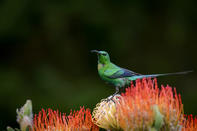A Testing One Day Outing

Route: From the Cathedral Peak car park at the boom, directly up Cathedral Peak and back.
Distance: 19 km
Duration: 7 to 8 hours
Grade: Extreme
General: This is a great hike, especially as a testing one-day outing for anyone staying a while in the Cathedral area. Although this hike affords you the chance to stand on top of one the Berg's more famous free-standing peaks, the path from Orange Peel Gap to the summit involves hairy scrambling and should not be attempted by anyone with a fear of heights or who is not hiking fit.
Route To Little Berg

Park at the guard house, where there is parking provided by the hotel for non-guests. Where the tarred road makes a U-bend up to the hotel, take the path up the left-hand bank of the Mlambonja Valley through the riverine bush towards the trout hatchery. After 500 m cross the river and continue up the opposite bank, climbing for another 500 m to a side junction on the level to the right.
Take the left-hand path here across a grassy area to the first band of sandstone cliffs. The path is wide but eroded in places, so keep to the track and step over rather than on the erosion barriers, and they will last longer. On reaching the cliffs the path zigzags to the right of the main sandstone band, then contours for a short distance before ascending diagonally through the cliffs to the top of a gully.
Bird Watching

The slopes here are dotted with proteas, which provide the principle food for Malachite sunbirds (metallic green with long, slender tails), and larger brown-and-yellow Guerney's sugarbirds with long flowing tails. The path crosses a small stream to emerge on top of a wide plateau, marking a dramatic change in both scenery and vegetation on top of the Little Berg.
At the base of the cliffs another path leads off to the right, along the contour into a wooded gorge where a delightful cascade runs into a pool surrounded by our forest familiars, and near the pool is the overhang known as Barker's Chalet.
The Little Berg here gives hikers a sense of either freeness or agoraphobia as it sweeps past Intunja ('eye of the needle') to the hefty bulk of Cathkin. Grey-winged francolins (which people here prefer to call 'partridges' or 'quails') and common quails (the little fluff-balls) are flushed out virtually at your feet as you walk. With a frenzied squawking and thrumping of wings the francolins burst up and fly a hundred or more metres off before descending into the grass. The quails are pretty much silent and dart out of the grass and back in just as quickly, almost defying your vision. Hardly surprising that very little is known about these birds.
Archetypal LBJs (little brown jobs), cisticolas, perch on tall grass sterns or low bushes (could be fantailed, or cloud, or Ayre's, or walling, or even desert LBJs). Halfway up this ridge, where clouds seem to have a permanent mooring, you'll find the beginning of the official Contour Path, leading off to the left above the convoluted ridges of Cathedral range and the bush line.
Orange Peel Gap

For the next 700 m the path heads up a steep gully followed by an even steeper ridge to the right before reaching an easy traverse for 2 km at around 2 400 m. (Halfway along here a minor path goes down a ridge to Sgonqweni Cave.) Now you begin the steep slog up to Orange Peel Gap, on a path that is very eroded; a section sometimes called Desperation Gully.
At the top of the gully you reach a shoulder that makes a good stop for a tea break, if the wind isn't howling. Then the path climbs the steep chute named Orange Peel Gap, which can be seen from the hotel.
Bell Contour Traverse

Now you are on the level of the Bell contour traverse (which is a nasty bit of grovelling along very steep, treacherous slopes all along the range to Twins Cave, past Bell Cave, 7 km away). The path from the top of the gap to the summit of Cathedral Peak (3 004 m) rises 300 vertical metres on only 200 map metres, which should give an idea of its severity. The route is marked by cairns, and although no rope is required it is about a C-grade scramble and should be attempted only by competent hikers.
Watch out for fickle weather because this ridge is very often in cloud - it's like a weather magnet. But of course the views are stupendous. The peak was first climbed in 1917 by the prolific climbing partnership of D Bassett-Smith and R Kingdon. Both were schoolmasters from the UK, the former teaching at Maritzburg College and the latter at Hilton, and they were founding members of the Natal Mountain Club.